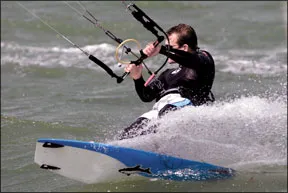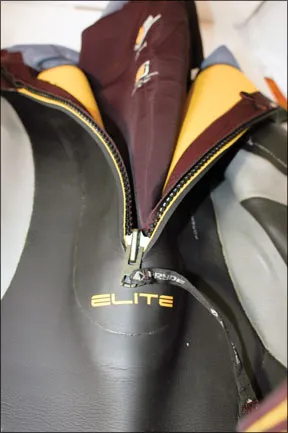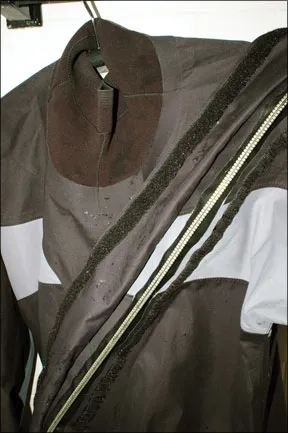Spring arrives in the minds of many sailors as soon as the ice has been carried out to sea. Its often the time when the breeze is consistent and only the temperature stands in the way of great sailing. Hypothermia is a concern, but the latest wetsuits, semi-drysuits, and full drysuits can add both comfort and safety to an early start.

The new drysuit technology is a quantum leap forward in both comfort and thermal efficiency. Unlike a wetsuit, which traps and warms a thin layer of water next to the skin, the drysuit keeps all water out. The drysuit is not a survival suit. (See story, facing page.) It allows more freedom of movement. Its made of multiple thin layers, and in some cases, a breathable fabric. The drysuit allows the user to dress like a mountaineer, with wicking undergarments (Practical Sailor, January 2006) close to the skin, followed by layers of fleece, hollow fill, or other high-tech insulating layers. Hands are uncovered, but a wide range of glove options are available (see Practical Sailor, September and November 2008), allowing a sailor to keep warm and still maintain dexterity. Many drysuits incorporate sealed booties that accommodate sock-covered feet. Deck boots or other footwear can be worn over the sealed socks, insuring that the toes stay toasty warm.
The semi-dry option is a high-tech wetsuit with some drysuit features. Neck and zipper seals and a unique top entry keep the chest and upper arm area of the neoprene suit dry. Legs and lower arms are warmed in wetsuit fashion by trapping a layer of water between the skin and the neoprene. Thicker material and high-tech insulation like Neil Pryde’s Zirconium yarn liner add warmth, and the combined effect delivers a suit thats both warm and flexible to wear. Wetsuits and semi-drysuits are often designated with numerals separated by a back slash. The first refers to the millimeter thickness of the torso portion of the suit and the second designation is the material thickness covering the extremities.

How We Tested
Practical Sailor looked at this technology from three perspectives: high-speed “wet boat” sailors with a passion for small, fast boats or boards; dinghy sailors who endure plenty of spray, but only occasionally end up swimming; and keel boat sailors who are looking for an alternative to foul-weather gear in cold and wet conditions.
The factors Practical Sailor ranked were relative warmth and comfort based upon the feedback from users who tried out each piece of gear. We also rated dexterity, based upon the wearers ability to carry out the various sailing tasks. All of the suits inhibited movement to varying degrees, so testers also tried to quantify how easy it was to carry out onboard tasks while wearing the suit. Testers also tracked how long they could wear the suit before they became cold or uncomfortable.
Quiksilver Cell 3/2
This 3/2 conventional wetsuit is a big boost to human thermal efficiency, and it gives the active dinghy sailor added incentive to launch on breezier days, when capsize is anything but a welcome chance to cool off. The suit works well with a PFD and a trapeze harness, and affords the agility sailors welcome both in and out of the water. Its the least thermal efficient of the suits we tested, but it was easy to pull on and off.

Bottom line: The suit is ideal for dinghy or board sailers to use during the few weeks before the water and air warm up to shorts and T-shirt conditions, and likewise it will extend fall sailing conditions by a couple of weeks.
Neil Pryde Elite II
This suit defines the cutting edge of neoprene technology, and its heavier but supple 5/3 construction adds significant insulation without giving up any ease of movement. A favorite among windsurfers and kiteboarders, the Elite II was well-received by dinghy sailors and even scored a surprising hit among keel-boat sailors dissatisfied with conventional foul-weather gear in cold and wet conditions. The outer shell material sheds water extremely well, and the soft neck keeps it comfortable. It proved to be much more versatile than a conventional wet suit, and because the torso area remains dry, it can be worn longer in comfort.
Bottom line: Eventually, hours spent living in non-breathable garments takes its toll, but anyone who regularly endures blasts of wave, rain, or spray will find this suit to be a good investment.
Douglas Gill Drysuit
To our dismay, were seeing more frostbite sailing gear that is all style and no substance, leaving the spectator to wonder if this is a sport or a fashion show. Gills front-zipper breathable drysuit turned out to be a pleasant surprise. Three layers of breathable material deliver comfort, flexibility, and excellent durability. The neoprene “glideskin” neck and wrists eliminate rash that was inevitable with old technology. From the tough outer skin and strategically placed patch reinforcements to the carefully taped seams, this suit is waterproof and winter-ready. The elastic waist and internal suspenders hold the suit in place, even when the wear is bending, ducking or twisting.

Bottom line: Targeted toward dinghy and sport boat sailors, the Gill drysuit also impressed the keelboaters, who liked the combination of improved breathability and extreme water protection.
Conclusion
Only after some time in the suits, did testers get a clear impression of their distinctions. The Quiksilver wetsuit prompted the “I need a shower” feeling sooner, that moment when you yearn for a fire and a big cup of hot cocoa. It nevertheless appealed to the super active board or small boat sailers, whose physical exertion kept them warmer. Dry suits, especially the breathable types, fared much better in this regard, as wearers remained more comfortable and content for longer periods.
While each suit has its niche, the Gill drysuit scored the highest marks overall for its warmth, comfort, and versatility. “Rugged and watertight” were unanimous tester comments, even after an immersion test in water just above freezing. It is well suited for a variety of sailors-not just college kids tacking around ice flows at the February start of their sailing season.


































I AM BRAND NEW TOALL OF THIS.I BOUGHT A MAGAZINE ABOUT AGING BOATS?
THAT SHOULD COME IN A HARD COPY IN THE MAIL………………………..RIGHT?
I ORDERED A WEEK AGO.
THANX IN ADVANCE
WAS $15 plus postage
was wondering when I might receive it in the mail?